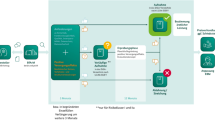Zusammenfassung
Digitale Angebote sollen eine zunehmende Bedeutung in der Gesundheitsversorgung in Deutschland einnehmen. Dies spiegelt sich im Gesetz zur Beschleunigung der Digitalisierung des Gesundheitswesens mit der Einführung der digitalen Gesundheitsanwendungen (DiGA) und in der aktuellen S3-Leitlinie Psychoonkologie wider. Während DiGA im Bereich Psyche ca. 41 % (Stand 28.02.2025) aller aktuellen DiGA ausmachen, ist der Anteil an krebsspezifischen Anwendungen deutlich geringer (4 %). Für eine Zertifizierung als DiGA wird innerhalb eines Jahres der Nachweis eines positiven Versorgungseffekts verlangt. Sucht man abseits der DiGA nach digitalen, mobilen Angeboten, findet sich ein vielfältiges, undurchsichtiges Angebot. Allgemeine Suchbegriffe wie Krebs führen mitunter zu unpassenden Vorschlägen in den App-Stores. Wie die Apps einzuordnen sind. ist eine Herausforderung sowohl für Behandelnde als auch für Patient*innen. Verschiedene Forschungsgruppen, Krankenkassen, Vereine oder Organisationen haben ihr Bewertungssystem für Apps – ein einheitliches System gibt es nicht. Kriterien wie Datenspeicherung, Finanzierung, Art des Anbieters, Ästhetik, Informationsgüte oder Zielangabe sind in unterschiedlichen Formulierungen oft Teil dieser Bewertungsempfehlungen. Um eine leitliniengerechte Versorgung zu erleichtern und Barrieren hinsichtlich der Nutzung von Apps abzubauen, werden im vorliegenden Artikel einige Problemfelder und bisherige Lösungsversuche in der Anwendung von (psycho-)onkologischen Apps aufgeführt sowie, anhand einer erstellten Broschüre, einige Apps auszugsweise vorgestellt.
Abstract
Digital services are playing an increasingly important role in healthcare in Germany. This is reflected in the law to accelerate the digitalisation of the healthcare system, with the introduction of digital health applications (DiGA) and in the current S3 guideline on psycho-oncology. While DiGA in the area of “psyche” account for approx. 41% (as of 28 February 2025) of all current DiGA, the proportion of cancer-specific applications is significantly lower (4%). Certification as a DiGA requires proof of a positive treatment effect within one year. If you search for digital, mobile offers other than DiGA, you will find a diverse, unclear range of offers. General search terms such as “cancer” sometimes lead to unsuitable suggestions in the app stores. How to categorise the apps is a challenge for both practitioners and patients. Different research groups, health insurance companies, associations or organisations have their own rating system for apps—there is no standardisation. Criteria such as data storage, financing, type of provider, aesthetics, quality of information or target information can be part of these evaluation recommendations in different formulations. In order to facilitate guideline-based care and reduce barriers with regard to the prescription and use of apps, this article lists some problem areas and previous attempts at solutions in the use of (psycho-)oncological apps and presents excerpts of apps based on a self-created overview.




Similar content being viewed by others
Literatur
Deutsche Krebsgesellschaft, AWMF, „Leitlinienprogramm Onkologie: Psychoonkologische Diagnostik, Beratung und Behandlung von erwachsenen Krebspatient*innen, Langversion 2.1, 2023, AWMF-Registernummer: 032-051OL,“ 2023
Bora AM et al (2023) The effectiveness of clinical guideline implementation strategies in oncology—a systematic review. BMC Health Serv Res 23(1):347. https://doi.org/10.1186/s12913-023-09189-x
Oh H, Rizo C, Enkin M, Jadad A (2005) What is ehealth?: a systematic review of published definitions. J Med Internet Res 7(1)
Nievas Soriano BJ, García SD, Fernández AMA, Bonillo Perales A, Parrón Carreño TP (2019) ehealth: advantages, disadvantages and guiding principles for the future. J Med Internet Res Prepr. https://doi.org/10.2196/preprints.15366
Bundesministerium für Gesundheit. E‑Health. https://www.bundesgesundheitsministerium.de/service/begriffe-von-a-z/e/e-health/. Zugegriffen: 19. Aug. 2024
Fatehi F, Samadbeik M, Kazemi A (2020) What is digital health? Review of definitions. Stud Health Technol Inform 275:67–71. https://doi.org/10.3233/SHTI200696
Bundesministerium für Gesundheit. Telemedizin. https://www.bundesgesundheitsministerium.de/service/begriffe-von-a-z/t/telemedizin/#:~:text=Telemedizin%20erm%C3%B6glicht%20es%2C%20unter%20Einsatz%20audiovisueller%20Kommunikationstechnologien%20trotz,z.B.%20Diagnostik%2C%20Konsultation%2C%20Monitoring%20und%20medizinische%20Notfalldienste%20anzubieten. Zugegriffen: 19. Aug. 2024
Albrecht UV (2016) Chancen und Risken von Gesundheits-Apps (CHARISMHA). Medizinische Hochschule Hannover. urn:nbn:de:gbv:084-16040811153. http://www.digibib.tu-bs.de/?docid=00060000
Konig IR et al (2022). Nachweis positiver Versorgungseffekt vn digitlen Gesundheitsanwendungen – methodische Herausforderungen und Lösungsansätze. Inn Med 63(12):1298–1306. https://doi.org/10.1007/s00108-022-01429-2.
Die forschenden Pharma-Unternehmen. DiGA Watchlist. https://www.vfa.de/de/wirtschaft-politik/pharma-digital/diga-watchlist. Zugegriffen: 19. Aug. 2024
Schinkothe T (2019) Individualized ehealth support for oncological therapy management. Breast Care 14(3):130–134. https://doi.org/10.1159/000500900
Zeeb H, Pigeot I, Schuz B (2020) Digital Public Health – Ein Überblick. Bundesgesundheitsblatt Gesundheitsforschung Gesundheitsschutz 63(2):137–144. https://doi.org/10.1007/s00103-019-03078-7
Ribaut J et al (2024) Developing a comprehensive list of criteria to evaluate the characteristics and quality of ehealth smartphone apps: systematic review. JMIR Mhealth Uhealth 12:e48625. https://doi.org/10.2196/48625
Messner EM et al (2020) The German version of the mobile app rating scale (MARS-G): development and validation study. JMIR Mhealth Uhealth 8(3):e14479. https://doi.org/10.2196/14479
Lable2Enable (2024) About Label2Enable. https://label2enable.eu/about-the-project. Zugegriffen: 19. Aug. 2024
Frauenhofer-Institut für offene Kommunikationssysteme (2024) APPKRI – Kriterien für Gesundheitsapps. https://www.fokus.fraunhofer.de/de/espri/projekt/appkri. Zugegriffen: 19. Aug. 2024
Kolominsky-Rabas PL, Tauscher M, Gerlach R, Perleth M, Dietzel N (2022) Wie belastbar sind Studien der aktuell dauerhaft aufgenommenen digitalen Gesundheitsanwendungen (DiGA)? Methodische Qualität der Studien zum Nachweis positiver Versorgungseffekte von DiGA. Z Evid Fortbild Qual Gesundhwes 175:1–16. https://doi.org/10.1016/j.zefq.2022.09.008
GKV Spitzenverband. Fokus: Digitale Gesundheitsanwendungen (DiGA). https://gkv-spitzenverband.de/gkv_spitzenverband/presse/fokus/fokus_diga.jsp. Zugegriffen: 19. Aug. 2024
TüV Verband „Der richtige Umgang mit Gesundheits-Apps“. https://www.tuev-verband.de/pressemitteilungen/der-richtige-umgang-mit-gesundheits-apps. Zugegriffen: 19. Aug. 2024
Norman CD, Skinner HA (2006) ehealth literacy: essential skills for consumer health in a networked world. J Med Internet Res 8(2):e9. https://doi.org/10.2196/jmir.8.2.e9
Dratva J, Schaeffer D, Zeeb H (2024) Digitale Gesundheitskompetenz der Bevölkerung in Deutschland: Aktueller Stand, Konzepte und Herausforderungen. Bundesgesundheitsblatt Gesundheitsforschung Gesundheitsschutz 67(3):277–284. https://doi.org/10.1007/s00103-024-03841-5
Hoogendoorn P, Trupec TP, Bufill CP & Borga L. “Health Apps From a Health Authority Perspective.” Zugegriffen: 19. Aug. 2024
Konig L, Kuhlmey A, Suhr R (2024) Digital health literacy of the population in Germany and its association with physical health, mental health, life satisfaction, and health behaviors: nationally representative survey study. JMIR Public Health Surveill 10:e48685. https://doi.org/10.2196/48685
TNS Political & Social at the request of the European Commission, Directorate-General Communication Networks, Content and Technology (2014) European citizens’ digital health literacy. In: Flash Eurobarometer 404.
Greiner W, Gensorowsky D, Witte J, Batram M (2022) DiGA-Report 2022. Techniker Krankenkasse, Hamburg
Singer S et al (2024) Digitale Gesundheitsanwendungen in der Psychoonkologie. Die Onkol 30(8):710–719. https://doi.org/10.1007/s00761-024-01556-5
Bundesministerium für Gesundheit, https://diga.bfarm.de/de/leistungserbringende. Zugegriffen: 19. Aug. 2024
Author information
Authors and Affiliations
Corresponding author
Ethics declarations
Interessenkonflikt
I. Maatouk befasst sich wissenschaftlich mit der Untersuchung von digitalen Interventionen in der Onkologie und hat Reisekostenerstattungen und Vortragshonorare von der PINK gegen Brustkrebs GmbH erhalten. Für die Nennung der in dem Artikel genannten Apps erfolgten keine Zahlungen oder sonstige Gegenleistungen von den Betreiberfirmen an den Autor oder die Autorinnen. S. Kiermeier, M. Grapp, C. Sauer und D. Bodschwinna geben an, dass kein Interessenkonflikt besteht.
Für diesen Beitrag wurden von den Autor*innen keine Studien an Menschen oder Tieren durchgeführt. Für die aufgeführten Studien gelten die jeweils dort angegebenen ethischen Richtlinien.
Additional information
Redaktion
Imad Maatouk, Würzburg
Hinweis des Verlags
Der Verlag bleibt in Hinblick auf geografische Zuordnungen und Gebietsbezeichnungen in veröffentlichten Karten und Institutsadressen neutral.
Disclaimer
Die in diesem Artikel vorgestellten und bewerteten Apps dienen der Information und stellen keine Empfehlung oder bevorzugte Nutzung bestimmter Produkte dar. Die Auswahl erfolgte nach bestem Wissen und Gewissen, basierend auf öffentlich zugänglichen Informationen zum Zeitpunkt der Veröffentlichung. Es wird empfohlen, vor der Nutzung eine individuelle Eignungsprüfung im jeweiligen Kontext vorzunehmen. Für die Nennung der in dem Artikel genannten Apps erfolgten keine Zahlungen oder sonstige Gegenleistungen von den Betreiberfirmen an den korrespondierenden Autor oder die Mitautorinnen.
Rights and permissions
About this article
Cite this article
Kiermeier, S., Grapp, M., Sauer, C. et al. Probleme und Lösungsansätze bei der Anwendung von Apps in der Psychoonkologie. best practice onkologie 20, 78–86 (2025). https://doi.org/10.1007/s11654-025-00639-y
Published:
Issue date:
DOI: https://doi.org/10.1007/s11654-025-00639-y




